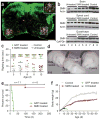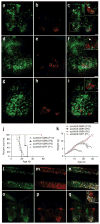Rescue of the spinal muscular atrophy phenotype in a mouse model by early postnatal delivery of SMN
- PMID: 20190738
- PMCID: PMC2889698
- DOI: 10.1038/nbt.1610
Rescue of the spinal muscular atrophy phenotype in a mouse model by early postnatal delivery of SMN
Retraction in
-
Retraction Note: Rescue of the spinal muscular atrophy phenotype in a mouse model by early postnatal delivery of SMN.Nat Biotechnol. 2022 Nov;40(11):1692. doi: 10.1038/s41587-022-01497-7. Nat Biotechnol. 2022. PMID: 36203015 Free PMC article. No abstract available.
Abstract
Spinal muscular atrophy (SMA), the most common autosomal recessive neurodegenerative disease affecting children, results in impaired motor neuron function. Despite knowledge of the pathogenic role of decreased survival motor neuron (SMN) protein levels, efforts to increase SMN have not resulted in a treatment for patients. We recently demonstrated that self-complementary adeno-associated virus 9 (scAAV9) can infect approximately 60% of motor neurons when injected intravenously into neonatal mice. Here we use scAAV9-mediated postnatal day 1 vascular gene delivery to replace SMN in SMA pups and rescue motor function, neuromuscular physiology and life span. Treatment on postnatal day 5 results in partial correction, whereas postnatal day 10 treatment has little effect, suggesting a developmental period in which scAAV9 therapy has maximal benefit. Notably, we also show extensive scAAV9-mediated motor neuron transduction after injection into a newborn cynomolgus macaque. This demonstration that scAAV9 traverses the blood-brain barrier in a nonhuman primate emphasizes the clinical potential of scAAV9 gene therapy for SMA.
Conflict of interest statement
The authors declare no competing financial interests.
Figures



Comment in
-
Genetic therapy for spinal muscular atrophy.Nat Biotechnol. 2010 Mar;28(3):235-7. doi: 10.1038/nbt0310-235. Nat Biotechnol. 2010. PMID: 20212484 No abstract available.
References
-
- McCarty DM, et al. Adeno-associated virus terminal repeat (TR) mutant generates self-complementary vectors to overcome the rate-limiting step to transduction in vivo. Gene Ther. 2003;10:2112–2118. - PubMed
-
- Lefebvre S, et al. Identification and characterization of a spinal muscular atrophy-determining gene. Cell. 1995;80:155–165. - PubMed
Publication types
MeSH terms
Substances
Grants and funding
LinkOut - more resources
Full Text Sources
Other Literature Sources
Medical

